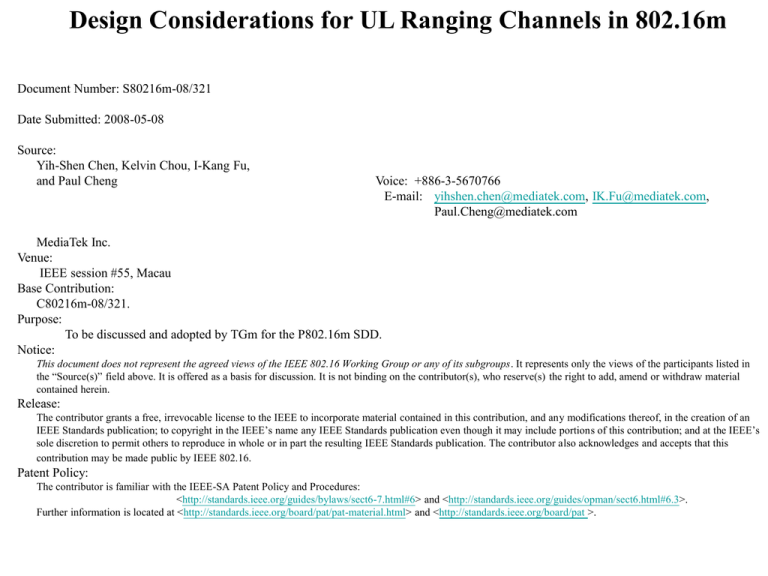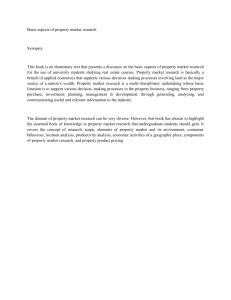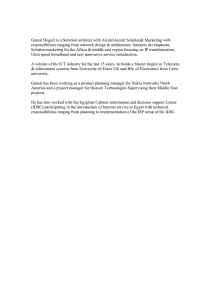Design Considerations for UL Ranging Channels in 802.16m
advertisement

Design Considerations for UL Ranging Channels in 802.16m Document Number: S80216m-08/321 Date Submitted: 2008-05-08 Source: Yih-Shen Chen, Kelvin Chou, I-Kang Fu, and Paul Cheng Voice: +886-3-5670766 E-mail: yihshen.chen@mediatek.com, IK.Fu@mediatek.com, Paul.Cheng@mediatek.com MediaTek Inc. Venue: IEEE session #55, Macau Base Contribution: C80216m-08/321. Purpose: To be discussed and adopted by TGm for the P802.16m SDD. Notice: This document does not represent the agreed views of the IEEE 802.16 Working Group or any of its subgroups. It represents only the views of the participants listed in the “Source(s)” field above. It is offered as a basis for discussion. It is not binding on the contributor(s), who reserve(s) the right to add, amend or withdraw material contained herein. Release: The contributor grants a free, irrevocable license to the IEEE to incorporate material contained in this contribution, and any modifications thereof, in the creation of an IEEE Standards publication; to copyright in the IEEE’s name any IEEE Standards publication even though it may include portions of this contribution; and at the IEEE’s sole discretion to permit others to reproduce in whole or in part the resulting IEEE Standards publication. The contributor also acknowledges and accepts that this contribution may be made public by IEEE 802.16. Patent Policy: The contributor is familiar with the IEEE-SA Patent Policy and Procedures: <http://standards.ieee.org/guides/bylaws/sect6-7.html#6> and <http://standards.ieee.org/guides/opman/sect6.html#6.3>. Further information is located at <http://standards.ieee.org/board/pat/pat-material.html> and <http://standards.ieee.org/board/pat >. Introduction & Motivation • Uplink (UL) ranging channel is a region where MSs maintain link quality or perform accessing to network • Issues on contention-based ranging channel – Code contention and collision – BW negotiation • Purpose and Summary – – – – Flexible UL ranging channel configuration Fast response mechanism for UL ranging channels Efficient BR ranging procedure Parameters for ranging request 2 UL Ranging Channel Configuration • In current 802.16e: – Four kinds of ranging requests: • Initial ranging, HO ranging, BR ranging, Periodic ranging – Two kinds of ranging channels: • Initial ranging/HO ranging, BR ranging/Periodic ranging – Four code sets: • Each code set is used exclusive for a specific ranging purpose 3 Comparison of Possible Partition Methods Advantage Overlapping partition Non-overlapping partition - High bandwidth efficiency -No collision between high and low priority rangings - Larger code pools for each ranging Disadvantage -High-priority ranging may - Low bandwidth efficiency collide with low-priority ranging - Smaller code pools for each ranging • The tradeoff criterion is network loading 4 Proposed Partition for UL Ranging Channels • G-RCH (General-purpose ranging channel) – applied for all ranging purposes • S-RCH (Specific-purpose ranging channel) – applied for a specific set of ranging purpose • D-RCH (Dedicated ranging channel) – applied upon the assignment from MAC management message for quick ranging. • The ranging codes for the G-RCH and S-RCH are partitioned accordingly 5 Example • If the network wants to reduce the forced termination rate for handover MSs, – HO ranging requests can be applied in S-RCH, and – the others are applied in G-RCH Initial ranging codes Total number of Ranging codes BR ranging codes Total number of Ranging codes HO ranging codes Periodic ranging codes G-RCH S-RCH An example of ranging code partition 6 Contention Resolution for UL Ranging • When an 802.16e MS sends a ranging code for initial ranging, it starts a T3 timer to wait the response from BS. • The overall delay causes by ranging collision can be calculated by Delay = (T3+backoff_time)*R, where T3 is the timer value ranging from 60ms to 200ms and R is the number of retry. MS BS Ranging code (collided) T3 Collision detected Backoff Ranging code CDMA Allocation IE 7 Discussion on Code Collision • Three possible scenarios for ranging code collision: 1. The ranging codes are not detected due to low SINR or multi-user collision 2. The ranging codes actually are detected, but no enough bandwidth can be allocated for the MS 3. At least two MSs have selected identical ranging code and ranging slot • For case 1and 2, the MS waits for T3 and gets no response, which results in undesirable long ranging latency – a fast response mechanism is required 8 Example: Ranging Status Indicator • A bitmap is used to indicate the receiving status of each RO within the ranging channel in the previous frame DL i UL i 1110 DL-MAP Preamble Ranging slots UL-MAP FCH DL-MAP Preamble FCH UL-MAP – 1: the ranging codes are correctly decoded – 0: the codes are not detectable or insufficient BW for future operation Collided slot 1101 Ranging status indicator DL i+1 UL i+1 9 BR Ranging Procedure • Typical BR ranging procedure consists of contention resolution phase and bandwidth negotiation phase – 5-step message transaction is required MS BS BR_RNG_CODE (1) Contention resolution phase CDMA_ALLOC_IE (2) BR header (3) Resource grant (4) Bandwidth negotiation phase UL data (5) 10 BR Ranging Procedure • Problems are: – Long transmission latency for real-time services or time-critical MAC management messages – Inefficient transmission for some short-burst services • ex: short message services, instant messages • Therefore, we suggest that the BR ranging codes may be further classified into two categories: – Variable-size BR ranging codes • Typical BR ranging procedure – Fixed-size BR ranging codes • Simplified BR ranging procedure 11 Simplified BR Ranging Procedure • The simplified BR ranging procedure takes only 3-step message transaction – bandwidth negotiation phase is skipped MS BS BR_RNG_CODE (1) Contention resolution phase CDMA_ALLOC_IE (2) UL data (5) • The UL bandwidth allocation may be – pre-defined and broadcasted by BS via broadcasting messages, or – negotiated during connection establishment 12 Parameters in the BR Ranging Procedure • During the bandwidth negotiation procedure, BS determines – the UL bandwidth allocation, and – the corresponding transmission format, UIUC • In some cases, BS may has no knowledge of absolute transmission power of MS – Power is updated by adjustment • To facilitate the allocation, we suggest the UL channel condition parameter may be also included into the BR header – the UL channel condition parameters may be • UL Tx power, • received CINR, or • recommended UIUC 13 Text Proposal • • • • 11.x Uplink Control Structures 11.x.y UL ranging channel 11.x.y.1 Configuration of UL ranging channel 11. x.y.2 Fast response message for UL ranging channel • 11.x.y.3 BR ranging procedure • 11.x.y.3.1 negotiation procedure • 11.x.y.3.2 Parameters in the BR ranging procedure 14




